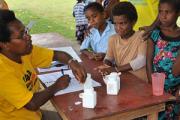Yaws in Vanuatu: On the way to eradication with a single pill
 On the tropical, volcanic island of Tanna, in the southernmost province of the Pacific Island nation of Vanuatu, the people proudly guard their traditional tribal lifestyle, resisting modern inventions and influences.
On the tropical, volcanic island of Tanna, in the southernmost province of the Pacific Island nation of Vanuatu, the people proudly guard their traditional tribal lifestyle, resisting modern inventions and influences.
Until July 2013, however, this idyllic setting was marred by a highly contagious disease that, in many communities, infected almost all of the children aged less than 15, causing weeping ulcers on their arms and legs. Some of them had been suffering for many years from this illness, which can result in chronic disfigurement and disability if left untreated.
Yaws is a bacterial infection that is transmitted by direct skin contact, particularly by children playing together and people living in overcrowded conditions.
WHO/P. Metois
Before the invention of antibiotics, the disease was widespread in most tropical countries. In the 1950s and 1960s, WHO and UNICEF held mass campaigns that treated around 50 million people with penicillin injections in 46 countries. These campaigns, combined with improvements in living conditions, led to a dramatic decline of almost 95% in yaws worldwide.
In the past 20 years, however, yaws has returned to Vanuatu in large numbers. A WHO-supported survey in 2011 found that the disease was particularly prevalent in Tafea province (which includes Tanna Island). In some communities, almost 90% of people were affected. The survey prompted WHO to start planning a mass drug administration campaign with the Vanuatu Ministry of Health, backed by funds from the Australian Government.
Oral antibiotic makes mass campaigns easier
New research from neighbouring Papua New Guinea helped simplify the task: the study showed that a single oral dose of the antibiotic azithromycin was at least as effective as penicillin injections at curing yaws. This significant finding has been the catalyst for a renewed global effort to eradicate the disease by 2020.
"Injections are much more complicated to use in the field. They are also painful – so children do not always cooperate with treatment campaigns. But with a single-dose, oral treatment, all you need is the pill and clean water," says Dr Kingsley Asiedu, in charge of yaws eradication at WHO Headquarters.
But before the mass drug campaign could start, the team knew that they faced a challenge to convince the people of Tafea to take part. Previous efforts to undertake campaigns had been unsuccessful, due to the remoteness of these island communities and a culture that was highly suspicious of modern medicine.
Convincing the people
"It was very important to get the acceptance of traditional village chiefs and other community leaders so that they would give permission for our teams to visit their villages and provide treatment to their people," says Ms Fasihah Taleo, national programme manager for neglected tropical diseases in the Vanuatu Ministry of Health.
“We invited the chiefs to a customary pig-killing ceremony and they took the (azithromycin) tablets in front of the public to show them how safe it is.”
Fasihah Taleo, Vanuatu Ministry of Health
"So we invited the chiefs to a customary pig-killing ceremony and they took the (azithromycin) tablets in front of the public to show them how safe it is." Radio programmes were broadcast in the local language to convince the people of the importance of taking part in the campaign.
Recent malaria elimination activities in the province had also paved the way for acceptance of health interventions with community leaders. “Large-scale indoor house spraying activities and health promotion campaigns to prevent malaria involved very close engagement with communities, which helped to build trust and support for the outreach activities of the Ministry of Health. Those close links became instrumental in the recent yaws campaign,” says Dr Lasse Vestergaard, from WHO’s malaria programme in the Western Pacific Region.
Success: coverage of 96%
In July 2013 over a two-week period, the mass drug campaign reached 96% of the population (almost 44 000 people) of Tafea Province. All age groups, except babies aged less than 6 months, were targeted regardless of whether they had symptoms.
“Many of the children had been walking around with yaws sores for years. Within a week of receiving the antibiotic treatment, their sores had disappeared," says Ms Taleo.
In the months following the campaign, just 6 cases of yaws were reported by the provinces main hospital, all of them in people who had arrived in Tafea after the campaign. After seeing the dramatic impact on neighbours and friends, several people who had refused treatment during the campaign came to health facilities asking to have the treatment after all.
Push to find and treat all cases
Since the campaign, Vanuatu has held a renewed push to find and treat all cases in the rest of the country. Dr Jacob Kool, WHO Country Liaison Officer in Vanuatu, emphasizes the importance of sustained surveillance over the next few years to ensure that any remaining or newly imported cases are quickly found and treated. "Health workers have been trained to recognize the disease and to report it to the authorities," he says. "Whenever a case of yaws is found, this is followed by a community mass treatment within the affected villages."
The campaign also played an important role in validating a newly developed rapid diagnostic test for yaws, in collaboration with the United States Centers for Diseases Control and an American biotechnology firm.
"We used the samples that we collected in Tafea to show that this simple test is reasonably reliable for diagnosis of yaws," says Dr Kool. "This will help all countries to be more effective now with the detection of the disease."
